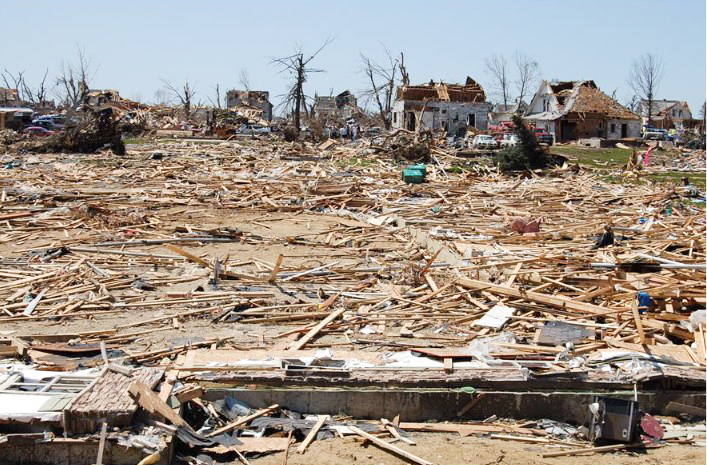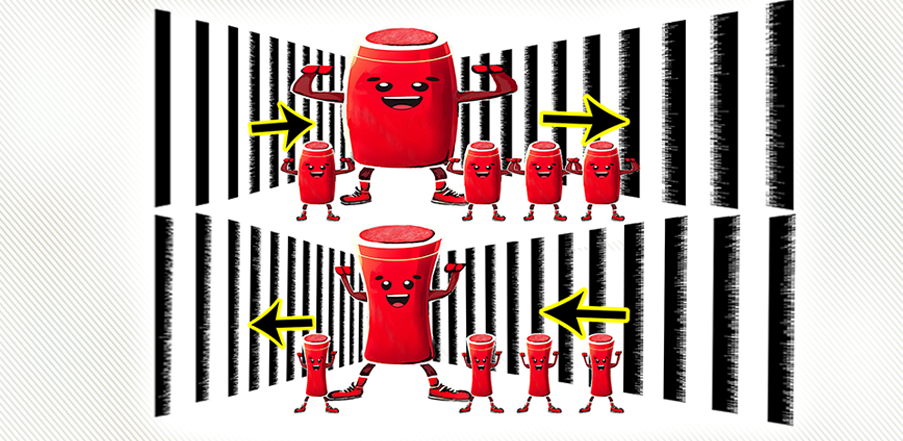
As part of his work to engineer buildings that can stand up to windstorms, Iowa State’s Partha Sarkar surveyed the damage left by the EF5 tornado that hit Parkersburg in May 2008. Larger photo. Photo by Partha Sarkar.
AMES, Iowa – The foundation of a house remains, the basement ripped open and exposed, with the rest of the house blown away. A brick-veneered bank building partially caved in. A collapsed high school gym. Gravestones knocked over. Debris piercing a building.
Partha Sarkar kept hitting next, scrolling through the photo evidence of the destruction he gathered and assessed the day after an EF5 tornado ripped through Parkersburg on May 25, 2008.
Then Sarkar, professor and interim chair of aerospace engineering at Iowa State University, opened a photo showing a house located on the edge of the tornado’s path. It was damaged, but still standing, shingles gone, but the roof structure mostly intact. Sarkar’s engineering studies, based on small-scale models of structures tested in wind tunnels, are designed to produce more of that – structures that stand up to extreme windstorms, protecting lives and property.
Now those studies, spanning his entire academic career, are getting a major upgrade – and the potential for acquiring a better and more powerful wind simulator.
Sarkar and a research team he’s leading have just won a four-year, $14 million grant from the U.S. National Science Foundation (NSF) to design and plan a National Testing Facility for Enhancing Wind Resiliency of Infrastructure in Tornado-Downburst-Gust Front Events, or NEWRITE.
If it’s built, the facility would allow testing at large-scales (a full-scale house or 1:10 scale models of buildings with large footprints such as retail buildings, shopping malls or hospitals) and high wind speeds (86-225 mph for EF1 to EF5 tornadoes, 100-125 mph for downbursts, 80-100 mph for gust fronts) in simulated windstorms.
“Being able to test structures at much larger scales, in extreme winds produced in these windstorms, will bring us closer to understanding reality and help engineers to improve the wind resilience of structures,” Sarkar said.
The grant will also support replacing Iowa State’s Tornado/Microburst Simulator that was completed in 2005. The existing simulator, housed in Howe Hall, is capable of 80 mph winds and a tornado-like vortex that’s 3.7 feet in diameter. The new simulator will be about a 1/20th-scale model of the full-scale NEWRITE and about the same size as the existing facility (18 feet in diameter) but will have the capacity to generate 225 mph tornado-like winds.
Researchers will also model and produce a “digital twin” of the full-scale and 1/20th-scale NEWRITE simulators to help them design the proposed facility.
Sarkar said the project is all about simulating tornadoes and other types of localized, non-synoptic windstorms, measuring the wind loads they exert on homes and other structures and engineering improvements that reduce structural damage.
“NEWRITE will be designed to be a state-of-the-art research and testing platform to mitigate the impacts of (localized windstorm) hazards on the built environment and significantly reduce fatalities and economic losses,” the researchers wrote.
Sarkar will lead the project team. Other project co-leaders are Alice Alipour, an associate professor of civil, construction and environmental engineering at Iowa State; Anupam Sharma, an associate professor of aerospace engineering at Iowa State; Guirong (Grace) Yan, an associate professor of structural engineering at Missouri University of Science and Technology in Rolla; and Delong Zuo, a professor of civil, environmental and construction engineering at Texas Tech University in Lubbock.
Other senior researchers (see sidebar) are from Iowa State, Clemson University in South Carolina; Northeastern University in Boston; the University of Arkansas in Fayetteville; the University of Florida in Gainesville; the University of Washington in Seattle; and the University of Wisconsin in Madison.
This design grant does not commit the NSF to supporting construction of the full-scale NEWRITE facility. If there is future support, Sarkar said it is likely to be built at Iowa State. He estimates the national testing facility would require a five-story building that could cover the square footage of four football fields. The facility would also require 5 to 10 megawatts of electricity.
In addition to NEWRITE, the NSF also awarded grants to three other research infrastructure projects: design of a laser laboratory at the University of Rochester in New York; an ocean observatory for earthquake activity at the University of Washington; and a cybersecurity institute at the University of Southern California in Los Angeles.
The four projects “exemplify the most novel, innovative infrastructure being designed and built in our country to advance the best ideas and train the highly skilled talent in science and engineering for our future,” said Sethuraman Panchanathan, director of the NSF. “By investing in the most innovative infrastructure, NSF aims to strengthen opportunities for all Americans and advance the frontiers of science and technology.”






.jpg?sfvrsn=97edde42_5)